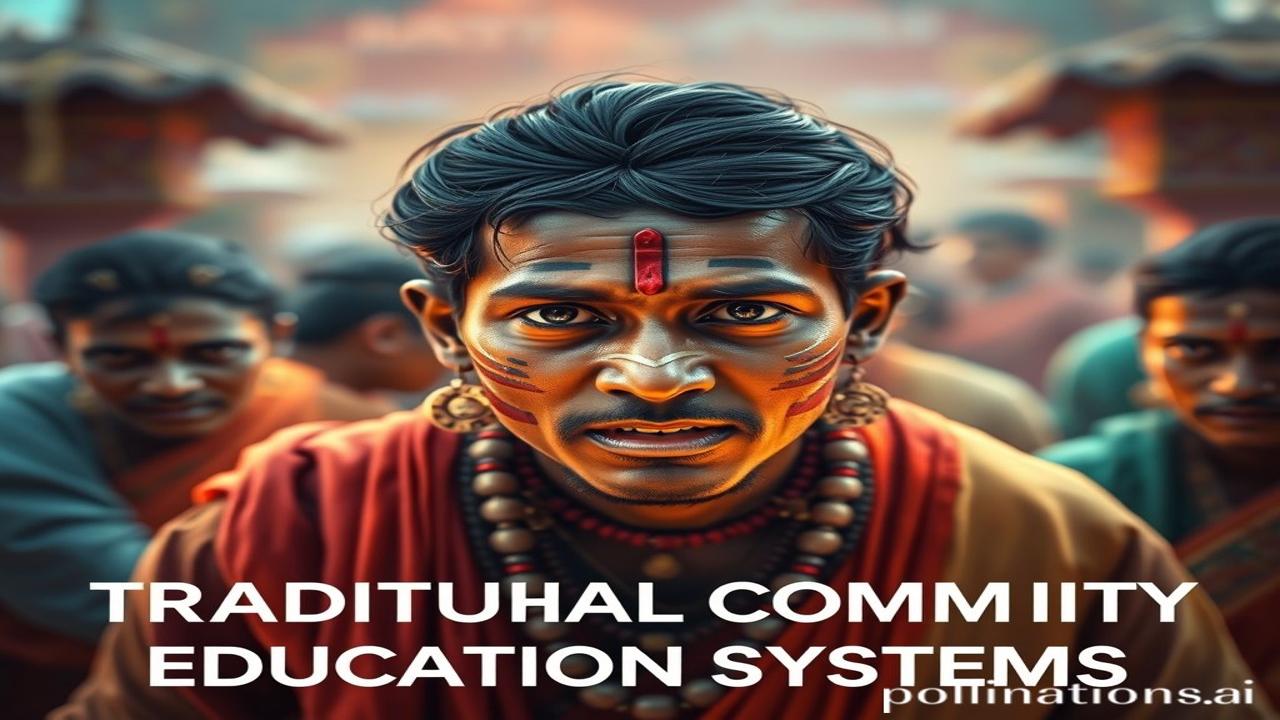Waqt Ki Dhool Mein Chhupi Vidya: Traditional Community Education Systems of India
Kabhi socha hai, jab internet nahi tha, jab schools itne aam nahi the, tab hamare ancestors kaise seekhte the? Imagine yourself walking down a dusty lane in ancient India, the air thick with the scent of sandalwood and burning incense. The rhythmic chanting of shlokas echoes from a nearby gurukul, mingling with the sounds of children reciting lessons. Yahi toh hai hamari dharohar, hamari pehchan – the rich tapestry of traditional community education systems.
Gurukul Se Panchayat Tak: Ek Itihaasic Jhalak (Historical Glimpse)
Traditional education in India was never confined to four walls. It flourished in gurukuls, temples, homes, and even under the shade of banyan trees. These systems were deeply intertwined with the community, reflecting its values, beliefs, and practical needs. Think about it – this wasn’t just about reading and writing; it was about survival, about art, about Dharma.
- Gurukuls: These residential schools, often nestled in forests or on riverbanks, were the heart of learning for Brahmins, Kshatriyas, and Vaishyas. Students lived with their Guru, learning not just from scriptures but also through practical skills like agriculture, warfare, or craftsmanship.
- Temples (Mandir): Temples weren’t just places of worship; they were also centers of learning, especially for arts, music, and dance. Think of the intricate sculptures and the natyamandapas – spaces dedicated to performing arts that passed down traditions through generations.
- Panchayats: In villages, panchayats played a vital role in imparting knowledge about community laws, governance, and conflict resolution. Elders shared their wisdom and experience, shaping the future leaders of the community.
- Artisan Guilds (Shreni): Imagine a bustling workshop filled with the clang of hammers and the scent of clay. Artisan guilds were crucial for training artisans in their respective crafts, ensuring the survival of traditional skills like pottery, weaving, and metalwork.
This happened over centuries, evolving with changing times and rulers. From the Vedic age to the Mughal era, different systems flourished, each contributing to the rich mosaic of Indian education.
Jeevan Ki Dhara: Kaise Jeete The Woh Din (Life as it was Lived)
Let’s step into the shoes of a young artisan, let’s say, a potter named Chintu, living in a small village in the Gupta era.
“Ma Rukmini ne aaj naye kapde pehne, kyunki mandir mein utsav tha. Chintu, who was barely eight, would spend his days learning the art of pottery from his father. Early morning, he’d help gather clay from the riverbank. Throughout the day, he’d watch his father expertly mold the clay into beautiful pots and lamps. The scent of wet earth and the rhythmic spinning of the potter’s wheel were his constant companions. His education wasn’t just about technique; it was about understanding the spirit of the craft, the connection between man and nature.
At night, under the starry sky, his grandfather would narrate stories from the Ramayana and the Mahabharata, instilling in him the values of Dharma, courage, and compassion. This was holistic education – not just about earning a livelihood but about living a meaningful life.”
Think also of a young prince, learning archery and statecraft from his Guru in a forest gurukul, preparing to rule his kingdom with wisdom and justice. Or a young girl learning the art of weaving intricate designs on silk sarees from her mother, preserving the family’s artistic heritage. These were the threads that held the fabric of society together.
Aaj Bhi Zinda: Virasat Ki Goonj (Echoes of the Past Today)
Though the formal education system dominates today, the spirit of community-based learning continues to resonate in many ways.
- Family Traditions: The passing down of family recipes, crafts, and rituals from one generation to another is a form of informal education.
- Folk Arts: Traditional dance forms, music, and storytelling continue to be preserved and taught within communities, keeping alive the rich cultural heritage of India.
- Community Workshops: Many organizations are now working to revive and promote traditional crafts through community workshops and training programs, empowering local artisans and preserving their skills.
- Yoga and Ayurveda: These ancient systems of knowledge are often taught through community-based programs, promoting holistic well-being and connecting people to their cultural roots.
This connection to Bharatiyata reminds us that education is not just about acquiring information but about cultivating wisdom, compassion, and a deep understanding of our cultural heritage.
Myth-Buster: Angrezi Shiksha Hi Sabkuch Nahi! (English Education Isn’t Everything!)
Log samajhte hain ki sirf Angrezi shiksha hi pragati ka raasta hai, lekin asli sach yeh hai ki hamari traditional education systems ne bhi Bharat ko anek gyani aur mahapurush diye hain. These systems fostered creativity, critical thinking, and a deep sense of social responsibility. It’s time we recognize and celebrate the value of these traditional approaches to learning.
Dristi Aur Bhavna: Anubhav Ka Sparsh (Sensory Experience)
Imagine the feel of cool mud between your fingers as you learn to shape a pot. Picture the vibrant colors of the silk threads as you learn to weave a saree. Hear the rhythmic chanting of shlokas as you absorb ancient wisdom. Smell the fragrant incense burning in the temple as you learn the art of dance. These sensory experiences were integral to the learning process, making it deeply personal and meaningful.
Antim Vichar: Gyan Ka Dipaak (Final Thoughts)
“सा विद्या या विमुक्तये” (Saa Vidyaa Yaa Vimuktaye) – That is knowledge which liberates. May we remember the spirit of these ancient systems and create a future where education empowers us to live meaningful and fulfilling lives, rooted in our cultural heritage. Let us light the lamp of knowledge, illuminating the path towards a brighter future for all.
